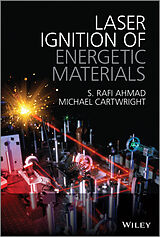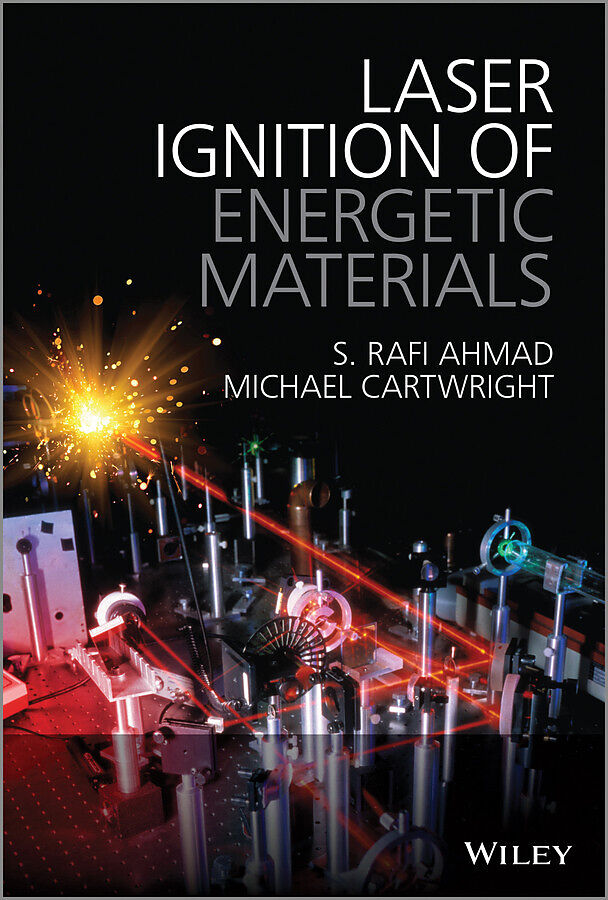Laser Ignition of Energetic Materials
Format:
E-Book (pdf)
EAN:
9781118683491
Untertitel:
Englisch
Genre:
Chemie
Autor:
S Rafi Ahmad, Michael Cartwright
Herausgeber:
Wiley
Anzahl Seiten:
304
Erscheinungsdatum:
25.08.2014
ISBN:
978-1-118-68349-1
The book gives an introduction to energetic materials and lasers, properties of such materials and the current methods for initiating energetic materials. The following chapters and sections highlight the properties of lasers, and safety aspects of their application. It covers the properties of in-service energetic materials, and also materials with prospects of being used as insensitive ammunitions in future weapon or missiles systems or as detonators in civilian (mining) applications. Because of the diversity of the topics some sections will naturally separate into different levels of expertise and knowledge.
Autorentext
Dr S Rafi Ahmad founded and led the Centre for Applied Laser Spectroscopy (CALS) within the Department of Applied Science, Security and Resilience, Cranfield University from 1988 to 2013. He has been active for the last 3 decades in managing/supervising many R&D projects and PhD research students in the field of directed laser and applied laser spectroscopy. Dr Ahmad has authored 52 peer-reviewed publications in scientific journals, and co-authored a book with Dr Cartwright.
Dr Michael Cartwright works on novel explosive compounds and the design of safer formulations and disposal of time expired and unexploded ordnance. He graduated in Chemistry from London University in the 1960s. His first employment was with the UKAEA at Windscale and Calder Hall establishment examining analytical methods for novel nuclear fuels and processing technologies. He researched on sterilisation methods for the Milton Division of Vick International followed by research in nuclear damage processes in solids and organo-metallic chemistry at the University of Bath before moving to Cranfield University at the Royal Military College of Science in 1986. Dr Cartwright has authored over 80 papers in refereed journals and published conference proceedings, and a co-authored book.
Inhalt
About the Authors xiii Preface xv Acknowledgements xvii 1 Historical Background 1 1.1 Introduction 1 1.2 The Gunpowder Era 2 1.3 Cannons, Muskets and Rockets 2 1.3.1 Musketry 7 1.3.2 Rocketry 9 1.4 Explosive Warheads 9 1.5 Explosives Science 11 Bibliography 14 2 Review of Laser Initiation 17 2.1 Introduction 17 2.2 Initiation Processes 19 2.3 Initiation by Direct Laser Irradiation 21 2.3.1 Laser Power 21 2.3.2 Laser Pulse Duration 22 2.3.3 Absorbing Centres 22 2.3.4 Pressed Density 23 2.3.5 Strength of Confining Container 24 2.3.6 Material Ageing 25 2.3.7 Laser-Induced Electrical Response 25 2.4 Laser-Driven Flyer Plate Initiations 25 2.5 Summary and Research Rationale 27 2.5.1 Rationale for Research 28 Bibliography 29 References 29 3 Lasers and Their Characteristics 35 3.1 Definition of Laser 35 3.2 Concept of Light 36 3.3 Parameters Characterizing Light Sources 39 3.4 Basic Principle of Lasers 45 3.5 Basic Technology of Lasers 47 3.6 Comparison between Laser and Thermal Sources 48 3.7 Suitable Laser Sources for Ignition Applications 49 3.7.1 Nd:YAG Laser 50 3.7.2 Light Emitting Diodes (LEDs) 50 3.7.3 Diode Lasers 52 3.8 Beam Delivery Methods for Laser Ignition 53 3.8.1 Free Space Delivery 53 3.8.2 Fibre Optics Beam Delivery 54 3.9 Laser Safety 57 3.9.1 Laser Interaction with Biological Tissues 57 3.9.2 Precaution against Ocular Hazards 57 Bibliography 59 4 General Characteristics of Energetic Materials 61 4.1 Introduction 61 4.2 The Nature of Explosions 61 4.3 Physical and Chemical Characteristics of Explosives 63 4.4 Fuel and Oxidizer Concept 64 4.4.1 Explosive Mixtures 66 4.4.2 Pyrotechnics 69 4.4.3 Rocket Propellants 73 4.5 Explosive Compounds 74 4.5.1 Chemical Classification 74 4.6 Thermodynamics of Explosions 80 4.6.1 Oxygen Balance 82 Appendix 4.A 83 A.1 Data for Some Explosives 83 A.1.1 TNT (Trinitrotoluene) 83 A.1.2 HNS(Hexanitrostilbene) 83 A.1.3 DATB (1,3,Diamino,2,4,6,trinitrobenzene) 84 A.1.4 TATB (1,3,5,-Triamino-2,4,6-Trinitrobenzene) 84 A.1.5 Picric Acid (2,4,6,trinito- hydroxy benzene) 84 A.1.6 Styphnic Acid (2,4,6,trinito-1,3, dihydroxy benzene) 84 A.1.7 Tetryl or CE (Composition Exploding) 85 A.1.8 PICRITE (Niroguanidine) 85 A.1.9 RDX (Research Department eXplosive) 85 A.1.10 HMX (High Molecular-weight eXplosive) 85 A.1.11 EGDN (Nitroglycol) 86 A.1.12 NG (Nitroglycerine) 86 A.1.13 NC (Nitro-Cellulose) 86 A.1.14 PETN (Pentaerythritol Tetranitrate) 87 A.1.15 Metal Salts 87 A.2 Unusual Explosives 88 A.2.1 Tetrazene 88 Bibliography 89 5 Recent Developments in Explosives 91 5.1 Introduction 91 5.2 Improvements in Explosive Performance 91 5.2.1 Heat of Explosion Hc (Q) 91 5.2.2 Density of Explosives 92 5.3 Areas under Development 92 5.3.1 New Requirements for Explosive Compositions 93 5.4 Plastic-Bonded High Explosives 95 5.4.1 Plastic-Bonded Compositions 95 5.4.2 Thermoplastics 96 5.4.3 Thermosetting Materials 96 5.5 Choice of High Explosive for Plastic Bonded Compositions 97 5.6 High-Energy Plastic Matrices 97 5.7 Reduced Sensitivity Explosives 99 5.8 High Positive Enthalpies of Formation Explosives 101 5.8.1 High Nitrogen-Containing Molecules 102 5.8....

Leider konnten wir für diesen Artikel keine Preise ermitteln ...
billigbuch.ch sucht jetzt für Sie die besten Angebote ...
Die aktuellen Verkaufspreise von 3 Onlineshops werden in Realtime abgefragt.
Sie können das gewünschte Produkt anschliessend direkt beim Anbieter Ihrer Wahl bestellen.
Loading...
Die aktuellen Verkaufspreise von 3 Onlineshops werden in Realtime abgefragt.
Sie können das gewünschte Produkt anschliessend direkt beim Anbieter Ihrer Wahl bestellen.
| # | Onlineshop | Preis CHF | Versand CHF | Total CHF | ||
|---|---|---|---|---|---|---|
| 1 | Seller | 0.00 | 0.00 | 0.00 |
